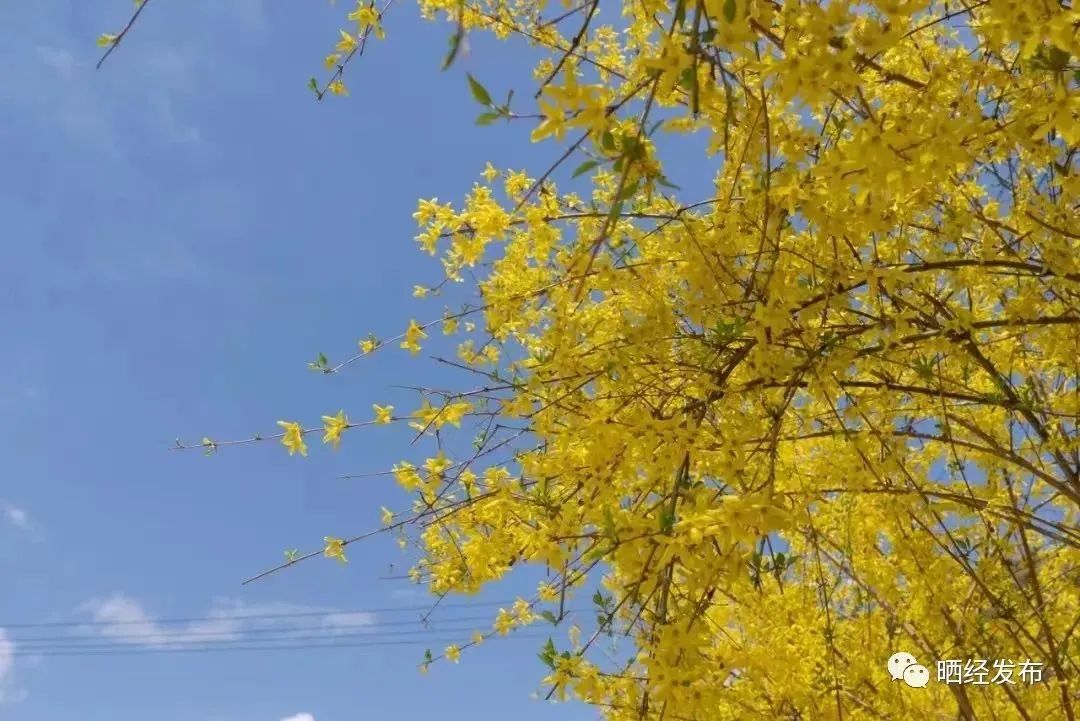Every rational person
is following the “Xihe Land and Resources” WeChat public platform

Forsythia, also known as Lian Qiao (连翘), Huang Shou Dan (黄寿丹), Huang Hua Gan (黄花杆), and Shou Dai Dan (绶带丹), belongs to the Oleaceae family. It is found in the northern, central, and northeastern provinces of China, and is now cultivated in many regions. Forsythia blooms in spring, with golden yellow flowers, making it an important early spring ornamental shrub, and its fruits are also commonly used in traditional Chinese medicine. The cultivation and management techniques are introduced as follows. 1. Morphological Characteristics and Biological Properties Forsythia is a deciduous shrub that can grow up to 3 meters tall, with upright, arching branches. The young branches are yellow-brown, slightly four-angled, and have distinct white lenticels, with hollow pith. The leaves are either simple or trifoliate, opposite, ovate to elliptical, measuring 4-9 cm in length, glabrous, with a sharp apex and a rounded to broadly wedge-shaped base, and the leaf margins are coarsely serrated. Flowers appear before the leaves, usually solitary, rarely in clusters of three; the calyx has four lobes, and the corolla is golden yellow with four lobes, shaped like inverted ovals; there are two types of stamens, one with longer stamens than pistils and the other with longer pistils than stamens, and these two types do not grow on the same plant. The flowering period is from April to May. The fruit is oval-shaped, with two chambers, and the seeds have wings, maturing from June to September.
 Forsythia prefers sunlight but can tolerate some shade; it can grow normally in sparse forests, although flowering is less abundant in shaded areas. It is cold-resistant and can survive freezing temperatures in northeastern provinces. Forsythia prefers moist conditions but is drought-tolerant and sensitive to waterlogging; it grows best in well-drained soils but should not be planted in low-lying areas where water can accumulate, as this can lead to root rot and death. It is not very demanding regarding soil types, growing normally in loamy, sandy loam, and light clay soils, but it thrives best in sandy loam and sandy soils. It has some salt and alkali tolerance, growing well in soils with a pH of 8.8 and a salt content of 0.2%. 2. Water and Fertilizer Management Forsythia is drought-tolerant but prefers a moist environment. In the first three years of cultivation, it is important to enhance watering; in addition to the initial three waterings, it should be watered 1-2 times a month from April to September, depending on temperature and rainfall. July and August are the peak rainfall months, and if the weather is not particularly dry, watering can be reduced or skipped. At the end of November or early December, thorough watering should be done to prevent freezing. The following year, in early March, watering should be done to thaw the soil, and watering should be controlled during flowering. After flowering, when new leaves emerge, a thorough watering should be done, and from April to September, watering should again be adjusted based on temperature and rainfall. The same watering method should be followed in the third year. From the fourth year onward, thorough watering should be done in early March and late November, and during the hot spring and summer months, watering should be adjusted based on rainfall, while other times should rely on natural growth.
Forsythia prefers sunlight but can tolerate some shade; it can grow normally in sparse forests, although flowering is less abundant in shaded areas. It is cold-resistant and can survive freezing temperatures in northeastern provinces. Forsythia prefers moist conditions but is drought-tolerant and sensitive to waterlogging; it grows best in well-drained soils but should not be planted in low-lying areas where water can accumulate, as this can lead to root rot and death. It is not very demanding regarding soil types, growing normally in loamy, sandy loam, and light clay soils, but it thrives best in sandy loam and sandy soils. It has some salt and alkali tolerance, growing well in soils with a pH of 8.8 and a salt content of 0.2%. 2. Water and Fertilizer Management Forsythia is drought-tolerant but prefers a moist environment. In the first three years of cultivation, it is important to enhance watering; in addition to the initial three waterings, it should be watered 1-2 times a month from April to September, depending on temperature and rainfall. July and August are the peak rainfall months, and if the weather is not particularly dry, watering can be reduced or skipped. At the end of November or early December, thorough watering should be done to prevent freezing. The following year, in early March, watering should be done to thaw the soil, and watering should be controlled during flowering. After flowering, when new leaves emerge, a thorough watering should be done, and from April to September, watering should again be adjusted based on temperature and rainfall. The same watering method should be followed in the third year. From the fourth year onward, thorough watering should be done in early March and late November, and during the hot spring and summer months, watering should be adjusted based on rainfall, while other times should rely on natural growth. Forsythia thrives with adequate fertilization, resulting in lush foliage and vibrant flowers. When fertilizing Forsythia, sufficient base fertilizer should be applied at planting, and in late autumn of the same year, a mixture of dried chicken manure or sesame residue should be applied with the antifreeze water. In the second year, nitrogen fertilizer should be applied after flowering, and during the flower bud differentiation period in July and August, a compound fertilizer with phosphorus and potassium should be applied. In late autumn, dried chicken manure should be applied again, and this method should be followed every year thereafter. 3. Pruning Methods The common shape of Forsythia is a bushy round head, but it can also be pruned into an umbrella shape, which looks very elegant when flowers bloom in the breeze, often used to decorate rocks and landscapes. When planting, select the most vigorous branch and cut it back to 40-50 cm above the ground, removing all other branches. New shoots will grow from the top of the retained main stem; select 3-4 evenly distributed branches with suitable angles to serve as main branches, removing all others. The retained main branches should be pruned to encourage more lateral branching. Since Forsythia branches are slender and soft, they tend to droop, forming an umbrella shape. Once the umbrella shape is basically formed, it is important to regularly remove suckers and pinch back the lateral branches, as well as thin out overly dense side branches to ensure good ventilation and light penetration.
Forsythia thrives with adequate fertilization, resulting in lush foliage and vibrant flowers. When fertilizing Forsythia, sufficient base fertilizer should be applied at planting, and in late autumn of the same year, a mixture of dried chicken manure or sesame residue should be applied with the antifreeze water. In the second year, nitrogen fertilizer should be applied after flowering, and during the flower bud differentiation period in July and August, a compound fertilizer with phosphorus and potassium should be applied. In late autumn, dried chicken manure should be applied again, and this method should be followed every year thereafter. 3. Pruning Methods The common shape of Forsythia is a bushy round head, but it can also be pruned into an umbrella shape, which looks very elegant when flowers bloom in the breeze, often used to decorate rocks and landscapes. When planting, select the most vigorous branch and cut it back to 40-50 cm above the ground, removing all other branches. New shoots will grow from the top of the retained main stem; select 3-4 evenly distributed branches with suitable angles to serve as main branches, removing all others. The retained main branches should be pruned to encourage more lateral branching. Since Forsythia branches are slender and soft, they tend to droop, forming an umbrella shape. Once the umbrella shape is basically formed, it is important to regularly remove suckers and pinch back the lateral branches, as well as thin out overly dense side branches to ensure good ventilation and light penetration.
4. Pest and Disease Control Common diseases of Forsythia include leaf spot disease, caused by fungi of the genus Alternaria. The pathogens first infect the leaf margins and gradually progress towards the center of the leaf, with a clear distinction between diseased and healthy areas. In the later stages of the disease, the entire leaf wilts and dies. This disease typically begins in mid to late May, with a peak incidence in July and August. High temperatures and humidity, along with poor ventilation, facilitate the spread of the disease. To prevent and control leaf spot disease, it is important to prune and remove excess and dense branches to maintain good ventilation and light penetration. Additionally, it is crucial to strengthen water and fertilizer management, ensuring a balanced nutrition and avoiding excessive nitrogen fertilization. If the disease occurs, spraying with 75% chlorothalonil wettable powder diluted to 1200 times or 50% carbendazim wettable powder diluted to 800 times can effectively control the disease, with applications every 10 days for 3-4 consecutive times.
 Common insect pests of Forsythia include: the striped broad-headed sharpshooter, the transparent broad-headed sharpshooter, the white mulberry scale, the ivy round scale, the round-spotted leaf roller, the nocturnal moth, the pine oak caterpillar, and the white-haired moth. If pests occur, during the period of nymph aggregation, spray with 10% imidacloprid wettable powder diluted to 2000 times or 25% insecticide suspension diluted to 1000 times to kill the transparent broad-headed sharpshooter and the striped broad-headed sharpshooter; during the peak of nymph hatching, spray with 95% acetamiprid emulsion diluted to 400 times, or 20% fast-kill emulsion diluted to 1000 times to kill the white mulberry scale; during the adult stage of the round-spotted leaf roller, spray with 3% high-concentration fenpropathrin emulsion diluted to 3000 times; during the larval stage of the nocturnal moth, spray with 20% confidor soluble agent diluted to 3000 times; during the early larval stage of the pine oak caterpillar, spray with 3% high-concentration fenpropathrin emulsion diluted to 3000 times; and during severe infestations of the white-haired moth, spray with 1.2% nicotine sulfate diluted to 1000 times. 5. Propagation Methods Propagation methods for Forsythia include: seeding, division, cutting, and layering. 1. Seeding In autumn, after the fruits mature, collect and dry the fruits, then beat them to obtain clean seeds. Store the seeds in a clean cloth bag at 5-10°C. In early March of the following year, initiate germination by soaking the seeds in a 1:2000 gibberellin alcohol solution for 4 hours to break dormancy, then mix the seeds with wet river sand at a weight ratio of 1:800. Under temperatures of 10-20°C, germination will occur in about 30 days. Then, use the drill sowing method with beds 150 cm wide, 20 cm high, and a depth of 3 cm, with a row spacing of 30 cm and 4 rows per bed. After sowing, lightly press the soil to ensure good contact between the seeds and soil, cover with a straw mat to keep the soil moist, and seedlings will emerge in about 20 days. Transplanting should be done in the following spring. 2. Cutting After flowering, select healthy, vigorous two-year-old branches from disease-free plants as cuttings, each cutting should be 12-15 cm long, with a flat cut at the top and a hoof-shaped cut at the bottom, with no less than 3 buds per cutting. Before cutting, soak the bottom end of the cuttings in an ABT rooting agent solution for 30 minutes. The spacing for cuttings should be 10×10 cm, with a depth of 8-10 cm. After cutting, cover the bed with a shelter and provide some shade to maintain moisture. Transplanting can be done in the following spring. 3. Layering In spring, select longer branches, bend them down and bury 3-5 cm into the soil, keeping the soil moist after sufficient watering. Roots will develop in about 2 months, and in autumn, cut the front end of the buried part for temporary planting, with permanent planting in the following spring. 4. Division In autumn, after the leaves fall, select robust plants with many suckers, dig them up, and cut them with a sharp knife, ensuring to keep the soil intact for replanting.
Common insect pests of Forsythia include: the striped broad-headed sharpshooter, the transparent broad-headed sharpshooter, the white mulberry scale, the ivy round scale, the round-spotted leaf roller, the nocturnal moth, the pine oak caterpillar, and the white-haired moth. If pests occur, during the period of nymph aggregation, spray with 10% imidacloprid wettable powder diluted to 2000 times or 25% insecticide suspension diluted to 1000 times to kill the transparent broad-headed sharpshooter and the striped broad-headed sharpshooter; during the peak of nymph hatching, spray with 95% acetamiprid emulsion diluted to 400 times, or 20% fast-kill emulsion diluted to 1000 times to kill the white mulberry scale; during the adult stage of the round-spotted leaf roller, spray with 3% high-concentration fenpropathrin emulsion diluted to 3000 times; during the larval stage of the nocturnal moth, spray with 20% confidor soluble agent diluted to 3000 times; during the early larval stage of the pine oak caterpillar, spray with 3% high-concentration fenpropathrin emulsion diluted to 3000 times; and during severe infestations of the white-haired moth, spray with 1.2% nicotine sulfate diluted to 1000 times. 5. Propagation Methods Propagation methods for Forsythia include: seeding, division, cutting, and layering. 1. Seeding In autumn, after the fruits mature, collect and dry the fruits, then beat them to obtain clean seeds. Store the seeds in a clean cloth bag at 5-10°C. In early March of the following year, initiate germination by soaking the seeds in a 1:2000 gibberellin alcohol solution for 4 hours to break dormancy, then mix the seeds with wet river sand at a weight ratio of 1:800. Under temperatures of 10-20°C, germination will occur in about 30 days. Then, use the drill sowing method with beds 150 cm wide, 20 cm high, and a depth of 3 cm, with a row spacing of 30 cm and 4 rows per bed. After sowing, lightly press the soil to ensure good contact between the seeds and soil, cover with a straw mat to keep the soil moist, and seedlings will emerge in about 20 days. Transplanting should be done in the following spring. 2. Cutting After flowering, select healthy, vigorous two-year-old branches from disease-free plants as cuttings, each cutting should be 12-15 cm long, with a flat cut at the top and a hoof-shaped cut at the bottom, with no less than 3 buds per cutting. Before cutting, soak the bottom end of the cuttings in an ABT rooting agent solution for 30 minutes. The spacing for cuttings should be 10×10 cm, with a depth of 8-10 cm. After cutting, cover the bed with a shelter and provide some shade to maintain moisture. Transplanting can be done in the following spring. 3. Layering In spring, select longer branches, bend them down and bury 3-5 cm into the soil, keeping the soil moist after sufficient watering. Roots will develop in about 2 months, and in autumn, cut the front end of the buried part for temporary planting, with permanent planting in the following spring. 4. Division In autumn, after the leaves fall, select robust plants with many suckers, dig them up, and cut them with a sharp knife, ensuring to keep the soil intact for replanting.
Haven’t followed “Xihe Natural Resources” yet? Don’t miss out on the exciting content!
Our WeChat ID:lnxhzrzy
 Thank you all for your attention and support!
Thank you all for your attention and support!

